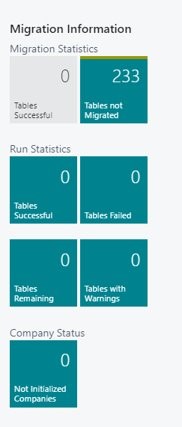In this article
Missing or corrupted data after cloud migration
Cloud Migration Management is where you schedule the data migration and monitor the progress. We recommend scheduling your data migration for off-peak business hours since running can take many hours.
The amount of time the migration will take to complete depends on the following:
- The amount of data.
- Your SQL configuration.
- Your connection speeds.
Subsequent migrations will complete more quickly because only changed data is migrating.
Running the migration
We recommend that you make sure that all users are logged out of both the source and target companies.
-
Click the
 icon, enter Cloud Migration Management and select the relevant link.
icon, enter Cloud Migration Management and select the relevant link. -
Select Run Migration Now.

-
You can follow the migration process from here.

-
When the migration is finished, you can go to My Settings and change to the migrated company.
We recommend that you create a sandbox environment by copying the production environment for testing.
Company initialization
When a company is created in Business Central, it must be initialized to ensure it is accessible and functional for everyone who needs to use it.
You can choose to mark a company as already initialized, such as if it was initialized in an earlier migration run. Technically, the initialization runs as a scheduled task in the job queue, and the status is automatically updated in the list of companies when a task completes. The process runs codeunit 2 - Company-Initialize.
-
Click the
 icon, enter Cloud Migration Management and select the relevant link.
icon, enter Cloud Migration Management and select the relevant link. -
Open Company Status.

-
Alternatively, search for Hybrid Companies List.
-
Select Schedule company initialization.

-
Wait until the initialization process has finished. It will take a few minutes.

Subsequent migrations
If you need to keep the business running while testing, the on-premises solution is your primary application for running your business, including activities such as data entry, tax reporting, and sending invoices.
You can run the migration more than once, and the migration process will only migrate changed tables.
Note: Business Central online/LS Central SaaS data will be overwritten. Therefore, it is important to wait to do any activities or modifications of data directly on the SaaS environment, until the migration process is finished and you are ready to work exclusively in the LS Central SaaS environment.
Disabling cloud migration
Once you have migrated the data that you want to migrate to LS Central SaaS, you end the migration by disabling cloud migration on the Cloud Migration Setup page.
This is an important step, because every time someone runs the migration, outstanding documents for vendors and customers, general ledger account numbers, inventory items, and any other changes made in the target company in Business Central online, are overwritten.

Missing or corrupted data after cloud migration
If cloud migration has been completed successfully, but pages in Business Central online/LS Central SaaS are not showing the expected data, or there are duplicate record exceptions thrown for setup tables, it is most likely due to table extensions missing records present in the base application.
For more information from Microsoft see Missing or corrupted data after cloud migration.